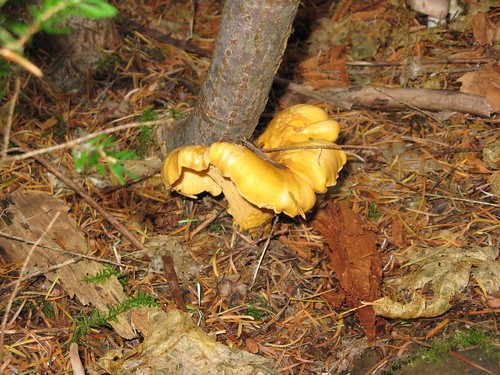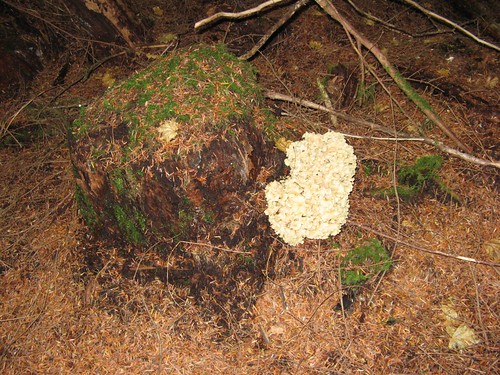
Figured a decent explanation of what I did pick and will enjoy eating from this week's picking trip was in order.
This first handsome mushroom is the famous Chanterelle (in this case, probably a Cantharellus formosus). A great beginner's mushroom, with few look alikes, bugs never invade them at all (an awesome trait that one realizes if you pick any Boletes, which get buggy quick), and just dandy for the table. Many would say that these are Cantharellus cibarius, even experts, and hell I won't argue with them. Fact of the matter is, they're both tasty and I'll take it. From a culinary standpoint, these are one of the world's favorite wild mushrooms. There are hordes of recipes (especially French) that use it.
I do know we run into a few other types of chanterelles in our pickings, and on this trip it was Yellowfoots, or Craterellus tubaeformis. The difference in appearance is subtle, but once you have been picking for a while it is easy to spot. Not worth wasting too many words on, as they too are tasty and I'll take em.
 Next is the majestic Cauliflower mushroom, Sparassis cripsa. A big, impressive, easy to identify edible. It maintains an al dente texture even after long cooking, which some say is why the name includes "crisp." Always love to find these in good condition, the grand majority I've seen were past their prime and melting down. Always a sad sight. As a culinary mushroom, this one has an interesting texture and a nice bold mushroomy taste. Not flowery like the Chanterelle, but almost meaty. The shape and texture make it a great noodle replacement in Stroganoff recipies.
Next is the majestic Cauliflower mushroom, Sparassis cripsa. A big, impressive, easy to identify edible. It maintains an al dente texture even after long cooking, which some say is why the name includes "crisp." Always love to find these in good condition, the grand majority I've seen were past their prime and melting down. Always a sad sight. As a culinary mushroom, this one has an interesting texture and a nice bold mushroomy taste. Not flowery like the Chanterelle, but almost meaty. The shape and texture make it a great noodle replacement in Stroganoff recipies. We found a nice little bunch of Honey Mushrooms, or Armillaria mellea growing out of the base of a Vine Maple. This is not a beginner's mushroom. It is brown (so many inedibles in the forest are brown, or "lbj's" -- little brown jobbies), and can be mistaken for a few other types of mushrooms. Once you get the spec's down, it becomes easy to figure out however, it just takes a trip or two with someone who is familiar with this species.

This is one of the mushrooms known to make some people a bit allergic/queasy depending on what substrate it grew on (since it always grows on or in a tree or rotting wood). It is always recommended for first timers to eat a few bites of this mushroom and then sit for a bit to make sure you aren't one of the people who react to it. I've eaten plenty of them to no effect so I collect them whenever I can. They can grow in impressively huge clumps, and make for quite a haul. For eating, the stems can be a bit stringy, but to me provide a nice textural quality. These mushrooms have a nice woodsy flavor, and are strong enough to hold up in mixed recipes.
We also found plenty of Shrimp Russula, Russula xerempelina. This is another "not a beginner" mushroom, as it has a look-alike that will make you puke, Russula emetica.
 Emetica often has a more candy-apple red cap, but the real test is virtually every Shrimp russula I pick I take a tiny bit, chew it up and let it sit on my tongue. Shrimps will be neutral, with possibly a tiny bit of pepperyness, but nothing major. Emetica will after a few seconds be incredibly hot, peppery, and bitter. It's not subtle. The reference guides love to talk about the shrimpy, fishy smell that these develop as something you can I.D. them with. In my experience, that smell only happens when they are really old and/or drying out. There is little to no smell on the young, succulent ones you will be picking. Take note of this fact, however, and if you have a dehydrator set up to dry a bunch of these, stick it outside or something, otherwise your house will smell like the bottom of a fisherman's dory in no time. Did that once and the house smelled for days. For cooking, they are mild and very tasty when fresh, sauteed like market mushrooms. But I think they are best used after drying, when their unique flavor is at its peak. Cream accents them well, so cream of mushroom soup is a good option for dried Shrimps.
Emetica often has a more candy-apple red cap, but the real test is virtually every Shrimp russula I pick I take a tiny bit, chew it up and let it sit on my tongue. Shrimps will be neutral, with possibly a tiny bit of pepperyness, but nothing major. Emetica will after a few seconds be incredibly hot, peppery, and bitter. It's not subtle. The reference guides love to talk about the shrimpy, fishy smell that these develop as something you can I.D. them with. In my experience, that smell only happens when they are really old and/or drying out. There is little to no smell on the young, succulent ones you will be picking. Take note of this fact, however, and if you have a dehydrator set up to dry a bunch of these, stick it outside or something, otherwise your house will smell like the bottom of a fisherman's dory in no time. Did that once and the house smelled for days. For cooking, they are mild and very tasty when fresh, sauteed like market mushrooms. But I think they are best used after drying, when their unique flavor is at its peak. Cream accents them well, so cream of mushroom soup is a good option for dried Shrimps. Ok, it's late and I need sleep, that's enough info for one post. I'll finish off with some boletes and Angel's Wings in the next day or two.
Enjoy your wild culinary delights,
Bp
ps: I took the first two photos, and the second two come from the articles that I link to about that particular mushroom.



2 comments:
Oh the old days here in Oregon! Thirty years ago outside Corvallis we'd take five gallon buckets up to chanterelle elevation and fill 'em up, then can them like tomatos. Now it's all closed off or fee required.
For that matter I could drive my truck up there and fill it with wood for the winter and not see a soul. All closed off and gated up now.
Out at Newport I'd walk out to the end of the north jetty and would have to stop fishing because the gunny sack was getting too full to carry. After the sea lion invasion and with all the crabbers and pollution that's just a fond memory.
Every summer we'd round up boats and tubes and families and beer and float/walk/swim down a few coastal stream miles, collecting crawfish, then have a giant feast with corn and salads. One helluva fine way to have a blast with the kids on a hot day. Too full of toxins now.
I feel old.
Hard to even imagine the abudance of this continent in days gone by. Thanks for the images nolo.
Post a Comment